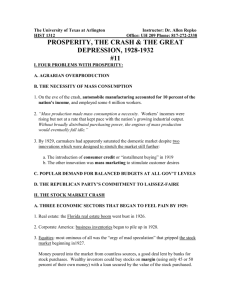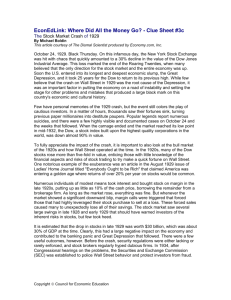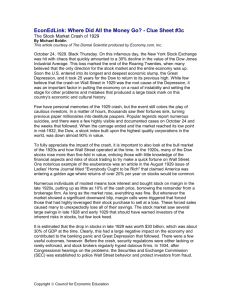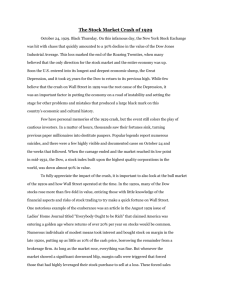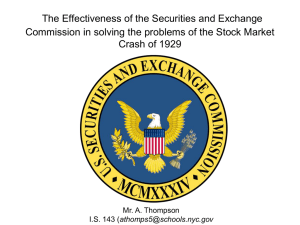File - Mr. P. Ronan
advertisement
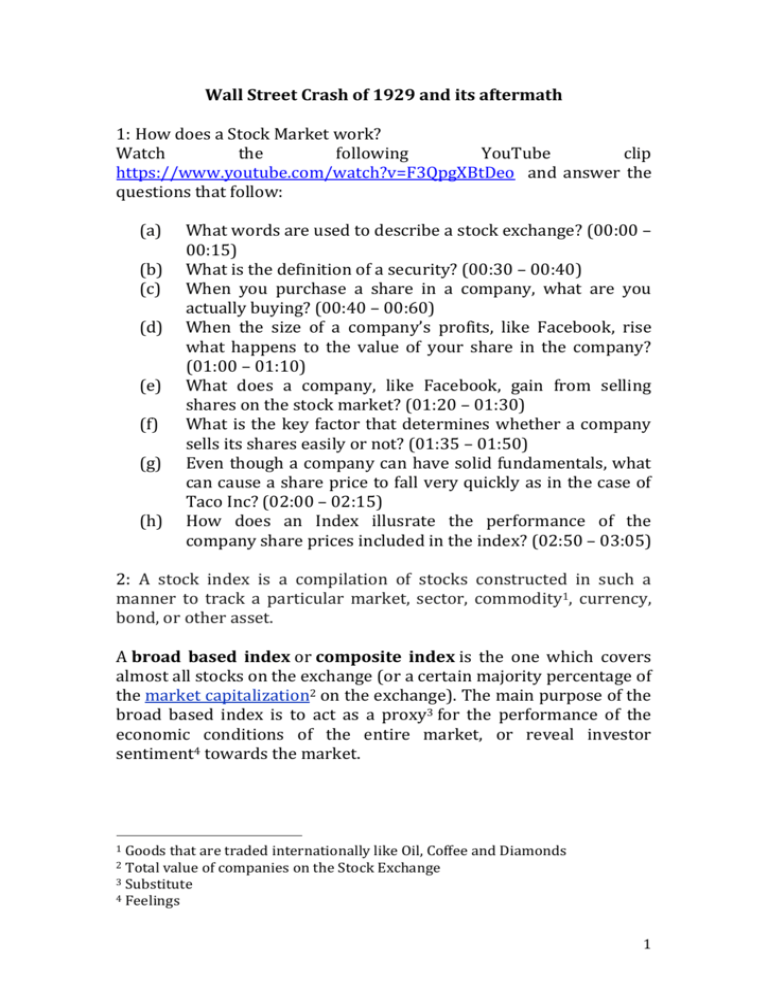
Wall Street Crash of 1929 and its aftermath 1: How does a Stock Market work? Watch the following YouTube clip https://www.youtube.com/watch?v=F3QpgXBtDeo and answer the questions that follow: (a) (b) (c) (d) (e) (f) (g) (h) What words are used to describe a stock exchange? (00:00 – 00:15) What is the definition of a security? (00:30 – 00:40) When you purchase a share in a company, what are you actually buying? (00:40 – 00:60) When the size of a company’s profits, like Facebook, rise what happens to the value of your share in the company? (01:00 – 01:10) What does a company, like Facebook, gain from selling shares on the stock market? (01:20 – 01:30) What is the key factor that determines whether a company sells its shares easily or not? (01:35 – 01:50) Even though a company can have solid fundamentals, what can cause a share price to fall very quickly as in the case of Taco Inc? (02:00 – 02:15) How does an Index illusrate the performance of the company share prices included in the index? (02:50 – 03:05) 2: A stock index is a compilation of stocks constructed in such a manner to track a particular market, sector, commodity1, currency, bond, or other asset. A broad based index or composite index is the one which covers almost all stocks on the exchange (or a certain majority percentage of the market capitalization2 on the exchange). The main purpose of the broad based index is to act as a proxy3 for the performance of the economic conditions of the entire market, or reveal investor sentiment4 towards the market. Goods that are traded internationally like Oil, Coffee and Diamonds Total value of companies on the Stock Exchange 3 Substitute 4 Feelings 1 2 1 Calculation of a Stock Index The S&P 500 is a U.S.market index that gives investors an idea of the overall movement in the U.S.equity market. The value of the S&P 500 constantly changes based on the movement of 500 underlying stocks. The index is computed by weighted average market capitalization. The first step in this methodology is to compute the market capitalization of each component in the index. This is done by taking the number of outstanding shares of each company and multiplying that number by the company's current share price, or market value. For example, if Apple Computer has roughly 830 million shares outstanding and its current market price is $53.55, the market capitalization for the company is $44.45 billion (830 million x $53.55). Next, the market capitalizations for all 500 component stocks are summed to obtain the total market capitalization of the S&P 500, as illustrated in the table below. This market capitalization number will fluctuate as the underlying share prices and outstanding share numbers change. 2 (a) Example of Calculation of Share Index Assume that the Dow Jones Industrial Index (DJIA) has 5 shares: Company name Market Capitalisation 1250 1000 750 500 1500 Exxon Mobil Apple Washington Post Cargill Goldman Sachs Total Weighting 0.25 0.20 0.15 0.10 0.30 When you calculate an index you must choose a base year Base Year: Index = 100 Company name Weighting Share Index Value Exxon Mobil 0.25 100 Apple 0.20 100 Washington Post 0.15 100 Cargill 0.10 100 Goldman Sachs 0.30 100 Share Index (summation of share index x weighting) Share Index value x weighting .25 x 100 = 25 .20 x 100 = 20 .15 x 100 = 15 .10 x 100 = 10 .30 x 100 = 30 =100 3 Year 2 Assume the following price changes occurred. Calculate the Share Index value Company name Weighting Share Index Value Share Index value x weighting Exxon Mobil 0.25 102 Apple 0.20 105 Washington Post 0.15 95 Cargill 0.10 90 Goldman Sachs 0.30 101 Share Index (summation of share index x weighting) Year 3 Assume the following price changes occurred. Calculate the Share Index value Company name Weighting Share Index Value Share Index value x weighting Exxon Mobil 0.25 108 Apple 0.20 106 Washington Post 0.15 88 Cargill 0.10 99 Goldman Sachs 0.30 90 Share Index (summation of share index x weighting) Year 4 Assume the following price changes occurred. Calculate the Share Index value Company name Weighting Share Index Value Share Index value x weighting Exxon Mobil 0.25 102 Apple 0.20 112 Washington Post 0.15 85 Cargill 0.10 104 Goldman Sachs 0.30 101 Share Index (summation of share index x weighting) 4 Year 5 Assume the following price changes occurred. Calculate the Share Index value Company name Weighting Share Index Value Share Index value x weighting Exxon Mobil 0.25 95 Apple 0.20 98 Washington Post 0.15 80 Cargill 0.10 92 Goldman Sachs 0.30 93 Share Index (summation of share index x weighting) (b) Now take the DJIA share index value for the five years and plot the values in a spreadsheet (c) Comment on the trend that is evident. 3: How would you invest in the Stock Market? Before you undertake the stock market simulations read the following information about stock indicators. Price/Earnings (P/E) ratio: This ratio describes how much one is paying for every dollar a company earns. It is a measure of how expensive shares are. For example, if a company's stock price is $15 per share, and it earned $1 per share over the preceding year, its P/E ratio would be 15. To give you some historical perspective, the average P/E ratio over the last 80 years has been 15.7 All else equal, the lower the P/E ratio, the less expensive stock prices are. 5 Dividend Yield: Many stocks pay dividends. Dividends are payments to shareholders from the company's earnings. The dividend yield is the dividend divided by the share price. As an example, suppose you buy stock at $10 a share and the company pays $1 per share in dividends. In this case, the dividend yield would be $1/$10 = 10%. For historical perspective, consider that the average dividend yield over the last 80 years has been 4.39 percent. All else equal, the higher the dividend yield, the more attractive stocks are. 3. Interest Rate: The one-year interest rate tells you how much you can expect to earn on bonds over the next year. Bonds are fixed-income instruments that guarantee a fixed return. Think of them as savings that you may have. The higher the interest rate, the more bonds pay and the less attractive stocks will be. Thus, as interest rates rise, stock prices generally fall as investors move money out of stocks and into bonds. Conversely, as interest rates decline, investors move wealth from bonds and into stocks. Simulation activity 1 (Under Exercises choose Interactive Activity) http://www.econedlink.org/lessons/index.php?lid=333&type=stude nt Simulation activity 2 (Under Process choose Interactive Activity) http://www.econedlink.org/lessons/index.php?lid=334&type=stude nt Simulation activity 3 (Under Process choose Interactive Activity) http://www.econedlink.org/lessons/index.php?lid=335&type=stude nt 6 4: Try the Investment Tolerance Quiz and see what type of potential investor you are http://njaes.rutgers.edu:8080/money/riskquiz/ 5: Wall Street Crash of 1929 Source The rich man's chauffer drove with his ears laid back to catch the news of an impending move in Bethlehem Steel; he held 50 shares himself. The window-cleaner at the banker's office paused to watch the ticker, for he was thinking of converting his savings into a few shares of Simmons ... a broker's valet who made nearly a quarter of a million on the market, a trained nurse who cleaned up $30,000 following the tips given her by grateful patients; and the Wyoming cattleman, 30 miles from the nearest railroad, who bought or sold 1,000 shares a day. Frederick Lewis Allen, Only Yesterday (1931) What does the above source imply about the extent of the sharebuying behaviour in US society during the 1920s? 6: Causes of the Wall Street Crash of 1929 Access the following website http://www.schoolhistory.co.uk/lessons/usa192941/crashcauses.ht ml and summarise in your own words the six main causes of the Wall Street Crash 7: Take the matchup quiz Access the following website and take the matchup test: http://www.schoolhistory.co.uk/lessons/usa192941/crashcausesm atchup.html 7 8: Movements in the Dow Jones Industrial Average Index View the following graphs and answer the questions that follow Graph 1: 1927 - 1931 (a) (b) (c) (d) (e) What was the value of the DJIA in 1927? Giving your best estimate, what was the value of the DJIA when it peaked in 1929? What was the percentage change in the DJIA value between the beginning of 1927 and its peak in 1929? Assume that the DJIA plummeted to a value of 230 on 29/10/1929, what was the percentage change between its peak in August 1929 and the value on 29/10/1929? What happened to the DJIA value after 29/10/1929 and up until March 1930? Why do you find this unusual? 8 Graph 2: 1927 - 1935 (a) (b) (c) (d) In what year did the DJIA bottom out? What value, in percentage terms, did the DJIA lose between its peak value in 1929 and its bottom value in 1932? In 1935, the DJIA value is 100. What is significant about the value of 100? Find out in what year did the DJIA recover to its pre-crash value in 1929 9 9: Stories of the carnage "This was real panic." Jonathan Leonard was a reporter who was on the scene as Wall Street tumbled. We join his story following "Black Thursday." "That Saturday and Sunday Wall Street hummed with week-day activity. The great buildings were ablaze with lights all night as sleepy clerks fought desperately to get the accounts in shape for the Monday opening. Horrified brokers watched the selling orders accumulate. It wasn't a flood; it was a deluge. Everybody wanted to sell-the man with five shares and the man with ten thousand. Evidently the week-end cheer barrage had not hit its mark. Monday was a rout for the banking pool, which was still supposed to be 'on guard.' If it did any net buying at all, which is doubtful, the market paid little attention. Leading stocks broke through the support levels as soon as trading started and kept sinking all day. Periodically the news would circulate that the banks were about to turn the tide as they had done on Thursday, but it didn't happen. A certain cynicism developed in the board rooms as the day wore on. Obviously the big financial interests had abandoned the market to its fate, probably intending to pick up the fragments cheap when the wreck hit the final bottom. 'Very well,' said the little man, 'I shall do the same.' When the market finally closed, 9,212,800 shares had been sold. The Times index of 25 industrials fell from 367.42 to 318.29. The whole list showed alarming losses, and margin calls were on their way to those speculators who had not already sold out. That night Wall Street was lit up like a Christmas tree. Restaurants, barber shops, and speakeasies were open and doing a roaring business. Messenger boys and runners raced through the streets whooping and singing at the tops of their lungs. Slum children invaded the district to play with balls of ticker tape. Well-dressed gentlemen fell asleep in lunch counters. All the downtown hotels, rooming houses, even flophouses were full of financial employees who usually slept in the Bronx. It was probably Wall Street's worst night. Not only had the day been bad, but everybody down to the youngest office boy had a pretty good idea of what was going to happen tomorrow. 10 The morning papers were black with the story of the Monday smash. Except for rather feeble hopes that the great banks would step into the gap they had no heart for cheerful headlines. In the inside pages, however, the Bewildered crowds on Wall Street sunshine chorus continued as merry as ever. Bankers said that heavy buying had been sighted on the horizon. Brokers were loud with "technical" reasons why the decline could not continue. The next day, Tuesday, the 29th of October, was the worst of all. In the first half hour 3,259,800 shares were traded, almost a full day's work for the laboring machinery of the Exchange. The selling pressure was wholly without precedent. It was coming from everywhere. The wires to other cities were jammed with frantic orders to sell. So were the cables, radio and telephones to Europe and the rest of the world. Buyers were few, sometimes wholly absent. Often the specialists stood baffled at their posts, sellers pressing around them and not a single buyer at any price. This was real panic. It was what the banks had prevented on Thursday, had slowed on Monday. Now they were helpless. Reportedly they were trying to force their associated corporations to toss their buying power into the whirlpool, but they were getting no results. Albert Conway, New York State Superintendent of Insurance, took the dubious step of urging the companies under his jurisdiction to buy common stocks. If they did so, their buying was insufficient to halt the rout." References: This account appears in: Leonard, Jonathan Norton, Three Years Down (1944); Allen, Frederick, Lewis, Since Yesterday: the 30's in America (1972). 11 Having read the above extract from a journalist, view the photographs on the Wall Street Crash http://www.businessinsider.com/stock-market-crash-of-19292011-11?op=1 Imagine that you are a journalist, write a brief article for your local newspaper explaining to your readers in Chicago the events of October 1929 in New York. 10: How did the Wall Street Crash of 1929 affect the Germany? ‘Over-heated During the 1920s, the economy of the United States was booming. It was the largest and richest economy in the world. People made fortunes by buying stocks and shares on the United States' stockmarket. Many borrowed money so that they could invest. Prices kept increasing, making people richer. But, too much money was chasing too few stocks resulting in the market becoming overheated. On 3 September 1929, stock prices reached an all-time high. Shortly, prices began to drop, leading to panic and mass-selling. By October 1929, the value of the market had nearly halved. This is known as the Wall Street Crash. Suddenly everyone wanted to get their money out. Banks did not have enough money to repay everyone or to lend to businesses. As a result businesses failed, leading to high unemployment across America. As economies were linked together, the rest of the world suffered too. During the 1920s, the German economy had been supported by loans from American banks. After the Wall Street Crash, the Americans wanted their money back and called in the loans. America gave Germany just 90 days to start repayments. Germany could not pay. As in America, German businesses failed. Unemployment reached more than four million by 1931. Germany suspended payment of reparations to the Allies.’ 12 Source: http://www.theholocaustexplained.org/ks4/the-nazi-riseto-power/was-the-economy-doomed-to-fail/what-were-theimmediate-effects-of-the-wall-street-crash/#.VKOEF4qUcmc (a) Access the following webpage and read the effect of the consequent Great Depression on German people from various walks of life http://www.theholocaustexplained.org/ks4/the-nazi-rise-topower/was-the-economy-doomed-to-fail/how-did-the-depressionaffect-german-people/#.VKOEuoqUcmc Having read the various stories answer the question: How might the Nazi Party have benefited from the Wall Street Crash? 13



